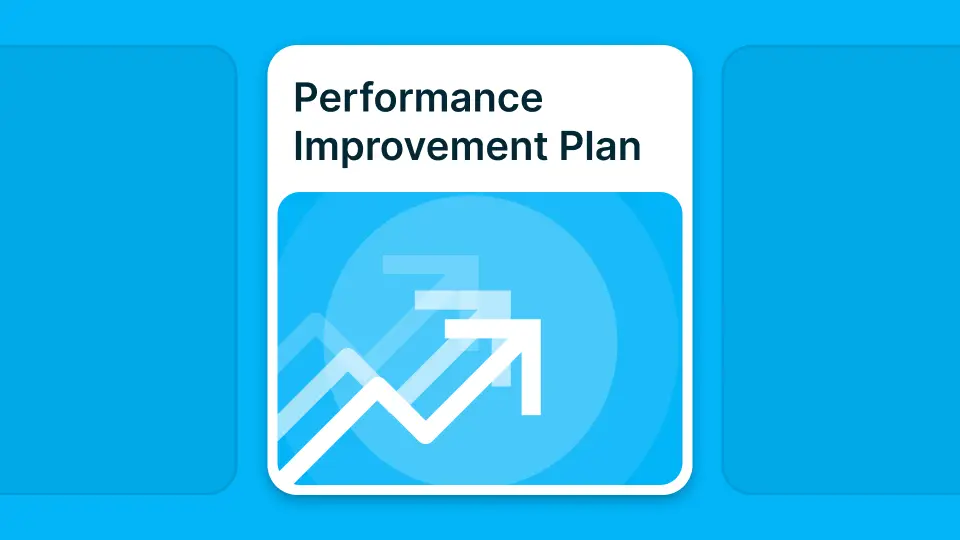Did you know that over 70% of PIPs fail to deliver lasting results, mostly due to vague goals and inconsistent follow-ups? The reality is stark: without proper structure and clear expectations, performance improvement plans become little more than paperwork exercises that frustrate both managers and employees.
This comprehensive guide provides you with copy-ready performance improvement plan templates for Word and Google Docs—complete with SMART goals, evidence tracking, support actions, and real-world examples tailored for Engineering, Sales, Customer Success, and Operations roles. You'll discover how to ensure fairness, avoid bias, stay compliant, and leverage automation tools like Atlas AI to streamline the entire process.
Here's what you'll gain from this resource:
Ready to transform your approach to performance management with templates that actually work? Let's explore what makes an effective PIP—and how you can implement it starting today.
1. What Is a Performance Improvement Plan Template?
A performance improvement plan template is a structured framework that transforms vague performance conversations into actionable roadmaps for employee success. Instead of relying on ad-hoc approaches that vary by manager, standardized templates ensure consistency across teams while reducing subjectivity in performance management.
Research from the Society for Human Resource Management shows that employees complete their PIPs successfully 35% more often when organizations use standardized templates versus improvised approaches. This isn't just about paperwork—it's about creating clear expectations that both parties understand from day one.
Consider a mid-sized SaaS company that struggled with high turnover in their sales department. After implementing standardized performance improvement plan templates, they saw retention improve by 18% within one quarter. Managers reported significantly less confusion about documentation requirements, and employees appreciated the transparent structure.
The most effective performance improvement plan templates include five core elements: specific performance issues identified through data, SMART goals that align with job expectations, documented evidence requirements, scheduled check-ins with predetermined frequency, and clear outcomes with success criteria. This structure eliminates ambiguity and creates shared understanding between managers and employees.
Templates also serve as legal protection for organizations. When performance issues escalate, having consistent documentation demonstrates fair treatment and due process. The key is ensuring every template follows the same format while allowing customization for different roles and performance gaps.
2. Essential Components of Effective PIP Templates
An effective performance improvement plan template goes beyond identifying problems—it creates a comprehensive support system with clear accountability measures. The most successful templates balance firm expectations with genuine support resources, ensuring employees have every opportunity to succeed.
Gallup research reveals that employees receiving weekly feedback are three times more likely to be engaged at work. This principle applies directly to PIPs: frequent check-ins dramatically improve completion rates compared to monthly or quarterly reviews. Organizations implementing weekly check-in schedules see improvement rates jump by up to 40%.
A global logistics company discovered this firsthand when they shifted from monthly to weekly PIP check-ins. Within two months, successful completion rates increased from 45% to 68%. The key difference wasn't just frequency—it was the structured approach their template provided for each interaction.
Your template should include signature lines for both employee and manager, creating formal acknowledgment of the plan's terms. Digital templates work exceptionally well here—Google Docs or Word documents allow real-time updates and version control throughout the improvement period.
The support actions section deserves special attention. Successful PIPs don't just demand improvement; they provide pathways to achieve it. This might include training programs, mentoring relationships, adjusted workloads during the improvement period, or access to new tools and resources. Document these commitments clearly to demonstrate organizational investment in employee success.
Remember that check-in frequency should match the severity of performance gaps. Critical issues may require daily brief check-ins initially, while skill development might work well with weekly sessions. Your template should provide flexibility in scheduling while maintaining consistent documentation standards.
3. Role-Based Performance Improvement Plan Examples
Different roles require fundamentally different approaches to performance improvement. What works for an Engineering team member struggling with code quality won't translate effectively to a Sales representative missing quotas or a Customer Success manager facing retention challenges.
LinkedIn Talent Solutions found that role-specific performance interventions increase positive outcomes by 28% compared to generic approaches. The reason is simple: each role has unique success metrics, skill requirements, and performance indicators that must be reflected in improvement plans.
Here's how this plays out in practice. An engineering manager at a fintech startup used a behavior-focused PIP template after repeated code review issues from a senior developer. The specific approach: zero critical bugs over two consecutive sprints, with evidence tracked through code review logs and support provided via pair programming sessions and code quality workshops. Within four weeks, bug counts dropped from four per sprint to zero, and the developer's confidence improved significantly.
For Sales roles, performance improvement plans typically focus on activity metrics and conversion rates. A template might track daily call volumes, meeting-to-proposal ratios, or pipeline velocity. The key is connecting activities to outcomes—not just demanding higher numbers without providing the skills and support to achieve them.
Customer Success roles require templates that balance relationship management with quantitative results. Successful PIPs in this area often include customer health scores, retention metrics, and satisfaction surveys alongside professional development in communication and problem-solving skills.
Operations teams benefit from process-focused templates that identify bottlenecks and inefficiencies. These plans typically include workflow analysis, quality control metrics, and cross-training opportunities to build more versatile skill sets.
The most effective role-based templates maintain consistent structure while adapting success metrics and support resources to match specific job functions. This ensures fairness across the organization while recognizing the unique challenges each role faces.
4. Ensuring Fairness and Mitigating Bias in Your PIPs
Bias in performance improvement plans creates legal risks and destroys employee trust. Fair, objective PIPs protect both organizations and employees by focusing on observable behaviors and measurable outcomes rather than subjective impressions or personality judgments.
Harvard Law Review research indicates that organizations using documented objective criteria reduce wrongful termination claims by approximately 50%. This protection comes from consistent application of standards and clear evidence trails that demonstrate due process.
A mid-sized retail chain learned this lesson when facing multiple grievances related to PIPs that included subjective "attitude" assessments. After restructuring their templates to focus on observable behaviors—such as customer complaint frequencies and response times—grievances dropped by 75% within six months.
Bias mitigation starts with template design. Remove subjective language and replace it with specific, measurable criteria. Instead of "improve attitude," specify "reduce customer complaints to fewer than 2 per month." Rather than "better teamwork," define "complete cross-departmental projects on schedule with positive peer feedback scores above 4.0."
Multiple reviewer involvement adds another layer of objectivity. Have HR representatives review PIP templates before implementation, and consider involving peer managers in goal-setting discussions. This collaborative approach reduces individual manager bias while ensuring consistency across departments.
Documentation timing matters significantly for fairness. Record meetings immediately after they occur, not days or weeks later when memory becomes unreliable. Use standardized meeting notes templates that capture specific examples, employee responses, and agreed-upon action items.
Provide clear appeals processes within your PIP templates. Employees should understand how to raise concerns about fairness or request modifications to goals or timelines. This transparency demonstrates organizational commitment to due process while identifying potential issues before they escalate.
Training managers on unconscious bias helps maintain template integrity over time. Even the best-designed templates can become ineffective if managers apply them inconsistently or add subjective interpretations during implementation.
5. Legal Considerations and Compliance Guidelines
Performance improvement plans must balance supportive coaching with legally defensible documentation. While this guide provides general best practices, nothing here substitutes for proper legal counsel specific to your jurisdiction and circumstances.
SHRM research shows that unclear documentation is the primary reason employers lose wrongful termination cases—accounting for roughly 80% of contested dismissals. The lesson is clear: detailed, consistent records protect both parties when performance improvement efforts don't succeed.
An international tech company faced this reality when they lost a labor dispute despite providing multiple verbal warnings to an underperforming employee. The lack of written documentation meant no evidence existed of their improvement efforts, resulting in significant financial penalties and damaged reputation.
Your performance improvement plan template should include specific disclaimer language stating that the document does not constitute legal advice and that organizations should consult with qualified employment attorneys regarding their specific situations. This protects against misinterpretation while encouraging appropriate professional consultation.
Signature requirements serve multiple purposes beyond legal protection. They create formal acknowledgment of the plan's terms, demonstrate employee awareness of consequences, and establish clear timelines for improvement efforts. Both employee and manager signatures should appear on every page of multi-page templates.
Storage and retention policies matter significantly for legal compliance. Maintain signed copies in secure, accessible locations according to local employment law requirements. Digital storage systems often provide better security and accessibility than physical files, but ensure they meet your jurisdiction's record-keeping standards.
Consider involving HR representatives in all PIP terminations, even when improvement plans appear straightforward. Their expertise helps ensure proper procedures are followed and appropriate documentation exists to support difficult decisions.
Remember that employment laws vary significantly by location and industry. What works in one jurisdiction may create problems in another, making local legal consultation essential for any organization implementing systematic performance improvement processes.
6. Automating Performance Improvement Plans with Atlas AI
Manual PIP creation consumes valuable time that HR professionals and managers could spend on actual coaching and support. Atlas AI transforms this administrative burden into an automated process that pre-fills templates using existing organizational data while maintaining the human touch where it matters most.
Gartner research indicates that HR automation reduces administrative workload by up to 40%, allowing professionals to focus on strategic initiatives rather than paperwork. For performance management specifically, this translates to approximately 7 hours saved per week for busy HR teams managing multiple improvement plans simultaneously.
A distributed fintech startup implemented Atlas AI's integration with their existing OKR system and saw dramatic improvements in intervention timing. Previously, performance issues were identified weeks or months after problems emerged. With automated data integration, managers received early warning signals and could initiate support conversations before formal PIPs became necessary.
Atlas AI pulls information from multiple sources to create comprehensive performance improvement plan templates. Past performance review data, 1-on-1 meeting notes, OKR progress tracking, and 360-degree feedback all contribute to pre-filled templates that reflect actual employee situations rather than generic boilerplate text.
The calendar integration feature ensures no check-ins are missed or forgotten. When creating a performance improvement plan through Atlas AI, the system automatically schedules recurring meetings with appropriate participants and sends reminders to both managers and employees. This consistency dramatically improves completion rates.
Analytics dashboards provide real-time visibility into PIP progress across the organization. HR leaders can identify patterns in performance issues, track manager effectiveness in supporting improvement efforts, and measure overall program success rates without manual data compilation.
Document generation capabilities mean completed templates can be instantly exported to Word or Google Docs formats for signature and formal processing. This flexibility accommodates different organizational preferences while maintaining consistent structure and content quality.
Atlas AI's machine learning capabilities improve template quality over time by analyzing successful versus unsuccessful improvement plans. The system identifies which types of goals, support actions, and check-in frequencies correlate with positive outcomes, making recommendations for future PIPs based on actual organizational data.
7. Implementation Guide and Internal Resources
Templates are only effective when implemented consistently and supported by comprehensive organizational processes. Success depends on manager training, employee communication, and integration with existing performance management systems.
Harvard Business Review research demonstrates that employees who understand the purpose behind their performance improvement plan are twice as likely to complete it successfully. This understanding comes from clear communication during implementation, not just well-designed templates.
A global business process outsourcing provider saw completion rates increase from 52% to 78% after linking their onboarding materials directly with downloadable PIP templates. New managers learned the system from day one, while existing staff received refresher training on consistent application.
Manager training should cover both template mechanics and communication skills. Technical aspects include how to set SMART goals, document evidence objectively, and schedule effective check-ins. Communication training focuses on delivering difficult messages with empathy while maintaining clear expectations.
Employee communication requires careful attention to timing and messaging. Introduce performance improvement plan templates as supportive tools, not punitive measures. Emphasize the organization's investment in employee success and the specific resources being provided to facilitate improvement.
Integration with existing systems maximizes template effectiveness. Connect PIP processes with performance review cycles, 1-on-1 meeting structures, and goal-setting frameworks already in use. This integration prevents duplicate efforts while ensuring consistent performance conversations throughout the year.
Regular process evaluation helps identify improvement opportunities. Collect feedback from both managers and employees who have participated in PIP processes. Common themes might include template sections that need clarification, support resources that prove most valuable, or timeline adjustments that improve success rates.
Consider establishing quarterly review sessions for your performance improvement plan process. Analyze completion rates, identify successful patterns, and adjust templates based on lessons learned. This continuous improvement approach ensures your system evolves with organizational needs and changing work environments.
Conclusion: Structured Plans Create Success Stories, Not Just Documentation
Performance improvement plan templates transform potentially contentious conversations into collaborative problem-solving opportunities. When designed with clear structure, objective metrics, and genuine support resources, PIPs become powerful tools for employee development rather than termination paperwork.
Three critical insights stand out from our analysis: First, standardized templates eliminate ambiguity and reduce disputes by creating shared understanding between managers and employees. Second, fairness depends entirely on objective evidence and consistent application—subjective assessments create legal risks and destroy trust. Third, automation through tools like Atlas AI saves significant time while improving consistency and follow-through across the organization.
Your next steps should focus on immediate implementation. Download role-specific templates and customize them for your organizational context. Train managers on fair, objective application of these tools. Consider pilot programs with willing departments before rolling out company-wide processes.
The future of performance management lies in digital-first approaches that combine human empathy with data-driven insights. As remote and hybrid work models continue expanding globally, expect even greater reliance on structured, automated systems that ensure high performance regardless of physical location or traditional supervision methods.
See our review platform for the best Performance Management Tools (German) so you can find the perfect fit for your needs.
Frequently Asked Questions (FAQ)
What is a performance improvement plan template?
A performance improvement plan template is a standardized document framework that guides managers through addressing employee underperformance with specific goals, timelines, support actions, and measurable outcomes. It ensures consistency across teams while providing clear structure for both managers and employees to follow during the improvement process.
How long should a typical performance improvement plan last?
Most effective PIPs run between 30 to 90 days depending on the complexity of issues being addressed. Simple skill gaps might require only 30-45 days, while behavioral changes or complex performance issues often need 60-90 days. The key is providing enough time for meaningful change while maintaining urgency and focus.
When should you use a behavior-focused versus performance-focused PIP template?
Use behavior-focused templates when addressing interpersonal issues, communication problems, or workplace conduct that doesn't directly relate to technical job performance. Performance-focused templates work better for productivity issues, skill gaps, or measurable output problems. Many situations require hybrid approaches that address both behavioral and performance elements.
Can these free Word and Google Docs templates be customized for different departments?
Absolutely. The templates are designed for easy customization across departments and roles. Engineering teams might focus on code quality metrics, while Sales teams emphasize conversion rates and revenue targets. Simply modify the goals, evidence requirements, and support actions sections to match your specific departmental needs and success metrics.
What happens if an employee doesn't meet the objectives in their performance improvement plan?
If documented objectives aren't met despite fair support and consistent application of the plan, next steps typically include role reassignment, additional training, or termination according to company policy. Always involve HR and consult legal counsel before making final decisions, as proper documentation and due process are essential for any adverse employment actions following PIP completion.













